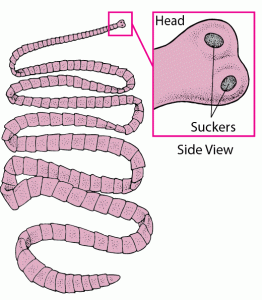Some of the most common tapeworms found in humans include:
- Taenia solium, commonly known as the pork tapeworm, is transmitted through the ingestion of undercooked pork containing the larvae of the tapeworm.
- Taenia saginata, also called the beef tapeworm, is transmitted through the consumption of raw or undercooked beef containing the tapeworm larvae.
- Diphyllobothrium, known as the fish tapeworm, is acquired by consuming raw or undercooked freshwater fish that harbor the tapeworm larvae.
- Hymenolepis, referred to as the dwarf tapeworm, is typically transmitted through the ingestion of food or water contaminated with tapeworm eggs.
Treatment
Treatment for tapeworm infestations typically involves oral medications, which are effective in eliminating the parasites from the body. Here are the key treatment options:
- Praziquantel: This medication is considered the drug of choice for treating tapeworm infections. It is usually administered orally in a single dose at a dosage of 10 mg per kilogram of body weight. Praziquantel works by disrupting the integrity of the tapeworm’s cell membrane, leading to paralysis and subsequent detachment of the worm from the intestinal wall.
- Niclosamide: Another option for treating tapeworm infections is niclosamide. This medication is also taken orally and works by interfering with the tapeworm’s ability to absorb glucose, leading to energy depletion and the death of the parasite. Niclosamide may be used as an alternative to praziquantel, particularly in cases where praziquantel is not available or contraindicated.
Both praziquantel and niclosamide are highly effective in eliminating tapeworms from the body and are generally well-tolerated by patients.
However, it is essential to follow the prescribed dosage and duration of treatment to ensure complete eradication of the parasites and prevent the recurrence of the infection.
In addition to medication, supportive measures such as maintaining good hygiene practices, proper sanitation, and thorough cooking of food can help prevent reinfection with tapeworms.
Education regarding preventive measures and the importance of seeking medical attention for suspected tapeworm infestations is also crucial for effective management of the condition.
Read more: Medical-Surgical Nursing
Read more: Roundworms | Causes | Signs and Symptoms | Risk Factors | Treatment | Nursing Management









[…] Read more: Tapeworms | Causes | Signs and symptoms | Treatment | Nursing Management […]